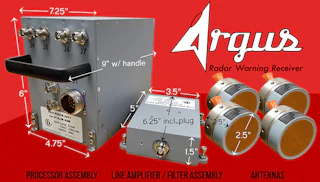PRODUCTS RADAR
Duotech RADAR products are scalable, cost-effective, and designed to integrate with existing platform mechanical and electrical parameters. We have extensive experience engineering high mean time between failure (MTBF) solutions that are modern yet backward compatible to align with legacy platform OEM standards.
Improved Low-Power Radio Frequency
The Improved Low-Power Radio Frequency (ILPRF) design replaces the obsolete and hard-to-find subassemblies with modern, supportable, and high-MTBF.
- Form-fit-function retrofit for APG-66 LPRF
- Mitigates obsolescence by removal of problematic RF SRU’s, but retains some original components to reduce costs and requalification efforts
- Long-term sustainable design
- Quick return on investment
- No minimum quantity requirements for upgrade
- All work performed at Duotech’s facilities and tested in accordance with OEM & USAF standards
- Reduce repair turnaround time with off-the-shelf components
- LRU can be reprogrammed to different channels to match Northrop’s original G0X configurations
- Take old non-repairable LRUs from stock to create new rotatable stock
Upgrade non-usable baseline LPRFs to (V)2 compatible LPRFs

Signal Receiver/Processor
- Adaptive processing and channel analysis
- Open architecture hardware design (e.g. VPX VITA, AXIe, 802.3, MIL-STD-1553, ARINC-429, and other standards)
- Standards-based tools and languages (VHDL, C#, Java, Matlab Coder)
- Modern processing techniques for legacy platforms
- Integrated master display and user interface when central computer unavailable
- User installable application » Feature extensions

ARES AESA
An internally developed and affordable airborne AESA designed to conform with multiple aircrafts.
- Cutting-edge high-power density
- GaN devices Integration with Duotech’s proven RADAR processor
- Built for total cost of ownership advantage
- User-customizable interface
- Target report hand-off to other systems
- Debrief with actual terrain and weather
- Full integration tool suite
- Prioritized threat model search modes
- Passive search capable

NEMESIS MESA
- Custom-tailored airborne RADAR designed to conform to your aircraft’s space and power requirements
- Utilizes cutting-edge signal processing techniques to provide pilots with the best and most capable solution
- Boasts a very high-MTBF
- Highly sustainable through the use of commercial off-the-shelf (COTS) and standards-based tools
- Can seamlessly integrate with existing and new mission systems
- Procurement cost is only a fraction compared to other RADAR solutions

ARGUS RADAR Warning Receiver
A highly affordable, digital threat detection system designed for a variety of platforms and applications.
- Connectivity via Internet for highly flexible integration path
- UDP or TCP/IP functionality for coordination or multiple different computing systems
- Stand-alone display and custom-tailored interface
- 4 or 6 channel
- 2-18 GHz or 8-11 GHz
- Full-featured integration tools
- High probability of detection for ultra-wide band threats

Portable RF Source
The portable radio frequency source provides a programmable frequency, pulsed test asset for outdoor use.
- X-band output frequencies
- Selected pulse period and repetition rates
- Option to default profiles
- Sunlight-readable display
- Standard primary cell batteries

